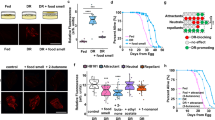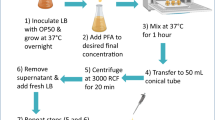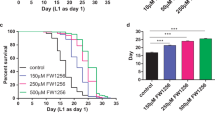Abstract
The mechanisms that determine the lifespan of an organism are still largely a mystery1. One goal of ageing research is to find drugs that would increase lifespan and vitality when given to an adult animal. To this end, we tested 88,000 chemicals for the ability to extend the lifespan of adult Caenorhabditis elegans nematodes. Here we report that a drug used as an antidepressant in humans increases C. elegans lifespan. In humans, this drug blocks neural signalling by the neurotransmitter serotonin. In C. elegans, the effect of the drug on lifespan is reduced or eradicated by mutations that affect serotonin synthesis, serotonin re-uptake at synapses, or either of two G-protein-coupled receptors: one that recognizes serotonin and the other that detects another neurotransmitter, octopamine. In vitro studies show that the drug acts as an antagonist at both receptors. Testing of the drug on dietary-restricted animals or animals with mutations that affect lifespan indicates that its effect on lifespan involves mechanisms associated with lifespan extension by dietary restriction. These studies indicate that lifespan can be extended by blocking certain types of neurotransmission implicated in food sensing in the adult animal, possibly leading to a state of perceived, although not real, starvation.
This is a preview of subscription content, access via your institution
Access options
Subscribe to this journal
Receive 51 print issues and online access
$199.00 per year
only $3.90 per issue
Buy this article
- Purchase on Springer Link
- Instant access to full article PDF
Prices may be subject to local taxes which are calculated during checkout



Similar content being viewed by others
References
Kirkwood, T. B. Understanding the odd science of aging. Cell 120, 437–447 (2005)
Kenyon, C. The plasticity of aging: insights from long-lived mutants. Cell 120, 449–460 (2005)
Finch, C. E. & Ruvkun, G. The genetics of aging. Annu. Rev. Genomics Hum. Genet. 2, 435–462 (2001)
Evason, K., Huang, C., Yamben, I., Covey, D. F. & Kornfeld, K. Anticonvulsant medications extend worm life-span. Science 307, 258–262 (2005)
Melov, S. et al. Extension of life-span with superoxide dismutase/catalase mimetics. Science 289, 1567–1569 (2000)
Kang, H. L., Benzer, S. & Min, K. T. Life extension in Drosophila by feeding a drug. Proc. Natl Acad. Sci. USA 99, 838–843 (2002)
Wood, J. G. et al. Sirtuin activators mimic caloric restriction and delay ageing in metazoans. Nature 430, 686–689 (2004)
Terzibasi, E., Valenzano, D. R. & Cellerino, A. The short-lived fish Nothobranchius furzeri as a new model system for aging studies. Exp. Gerontol. 42, 81–89 (2007)
Gillman, P. K. A systematic review of the serotonergic effects of mirtazapine in humans: implications for its dual action status. Hum. Psychopharmacol. 21, 117–125 (2006)
Dempsey, C. M., Mackenzie, S. M., Gargus, A., Blanco, G. & Sze, J. Y. Serotonin (5HT), fluoxetine, imipramine and dopamine target distinct 5HT receptor signaling to modulate Caenorhabditis elegans egg-laying behavior. Genetics 169, 1425–1436 (2005)
Horvitz, H. R., Chalfie, M., Trent, C., Sulston, J. E. & Evans, P. D. Serotonin and octopamine in the nematode Caenorhabditis elegans . Science 216, 1012–1014 (1982)
Rodin, G. et al. Treatment of depression in cancer patients. Curr. Oncol. 14, 180–188 (2004)
Sze, J. Y., Victor, M., Loer, C., Shi, Y. & Ruvkun, G. Food and metabolic signalling defects in a Caenorhabditis elegans serotonin-synthesis mutant. Nature 403, 560–564 (2000)
Ranganathan, R., Sawin, E. R., Trent, C. & Horvitz, H. R. Mutations in the Caenorhabditis elegans serotonin reuptake transporter MOD-5 reveal serotonin-dependent and -independent activities of fluoxetine. J. Neurosci. 21, 5871–5884 (2001)
Komuniecki, R. W., Hobson, R. J., Rex, E. B., Hapiak, V. M. & Komuniecki, P. R. Biogenic amine receptors in parasitic nematodes: what can be learned from Caenorhabditis elegans? Mol. Biochem. Parasitol. 137, 1–11 (2004)
Suo, S., Kimura, Y. & Van Tol, H. H. Starvation induces cAMP response element-binding protein-dependent gene expression through octopamine-Gq signaling in Caenorhabditis elegans . J. Neurosci. 26, 10082–10090 (2006)
Murakami, H. & Murakami, S. Serotonin receptors antagonistically modulate Caenorhabditis elegans longevity. Aging Cell 6, 483–488 (2007)
Roeder, T. Octopamine in invertebrates. Prog. Neurobiol. 59, 533–561 (1999)
Malnic, B., Hirono, J., Sato, T. & Buck, L. B. Combinatorial receptor codes for odors. Cell 96, 713–723 (1999)
Liberles, S. D. & Buck, L. B. A second class of chemosensory receptors in the olfactory epithelium. Nature 442, 645–650 (2006)
Offermanns, S. & Simon, M. I. Gα15 and Gα16 couple a wide variety of receptors to phospholipase C . J. Biol. Chem. 270, 15175–15180 (1995)
Luquet, S., Perez, F. A., Hnasko, T. S. & Palmiter, R. D. NPY/AgRP neurons are essential for feeding in adult mice but can be ablated in neonates. Science 310, 683–685 (2005)
Lakowski, B. & Hekimi, S. Determination of life-span in Caenorhabditis elegans by four clock genes. Science 272, 1010–1013 (1996)
Lakowski, B. & Hekimi, S. The genetics of caloric restriction in Caenorhabditis elegans . Proc. Natl Acad. Sci. USA 95, 13091–13096 (1998)
Niacaris, T. & Avery, L. Serotonin regulates repolarization of the C. elegans pharyngeal muscle. J. Exp. Biol. 206, 223–231 (2003)
Kaeberlein, T. L. et al. Lifespan extension in Caenorhabditis elegans by complete removal of food. Aging Cell 5, 487–494 (2006)
Harris, B. & Harper, M. Unusual appetites in patients on mianserin. Lancet 1, 590 (1980)
Johnson, T. E. et al. Relationship between increased longevity and stress resistance as assessed through gerontogene mutations in Caenorhabditis elegans . Exp. Gerontol. 36, 1609–1617 (2001)
Brenner, S. The genetics of Caenorhabditis elegans . Genetics 77, 71–94 (1974)
Acknowledgements
We are grateful to J. Priess for critical reading of an earlier version of the manuscript, to members of the Priess and Buck laboratories for advice and discussions, and to J. Vazquez for technical assistance. We thank S. Suo for providing the VN11 strain (ser-3(ad1774);tzIs3[cre::gfp, lin-15(+)]) and J. Ying Sze for the ser-4(ok512);yzEx205[ser-4(+); pRF4(rol-6(su1006))] strain. All other strains were provided by the Caenorhabditis Genetics Center, which is funded by the NIH, and the international C. elegans Gene Knockout Consortium. This project was supported by the Howard Hughes Medical Institute and the Ellison Medical Foundation.
Author information
Authors and Affiliations
Corresponding author
Supplementary information
Supplementary Information
The file contains Supplementary Figure 1 and Supplementary Tables 1-4 with Legends. (PDF 6204 kb)
Rights and permissions
About this article
Cite this article
Petrascheck, M., Ye, X. & Buck, L. An antidepressant that extends lifespan in adult Caenorhabditis elegans. Nature 450, 553–556 (2007). https://doi.org/10.1038/nature05991
Received:
Accepted:
Issue Date:
DOI: https://doi.org/10.1038/nature05991
This article is cited by
-
The million-molecule challenge: a moonshot project to rapidly advance longevity intervention discovery
GeroScience (2023)
-
Dopamine D1- and D2-like receptors oppositely regulate lifespan via a dietary restriction mechanism in Caenorhabditis elegans
BMC Biology (2022)
-
A laboratory and simulation platform to integrate individual life history traits and population dynamics
Nature Computational Science (2022)
-
Serotonin and dopamine modulate aging in response to food odor and availability
Nature Communications (2022)
-
G protein-coupled receptors that influence lifespan of human and animal models
Biogerontology (2022)
Comments
By submitting a comment you agree to abide by our Terms and Community Guidelines. If you find something abusive or that does not comply with our terms or guidelines please flag it as inappropriate.



